| Pages:
1
..
13
14
15
16
17
..
27 |
Pulverulescent
National Hazard
   
Posts: 793
Registered: 31-1-2008
Member Is Offline
Mood: Torn between two monikers ─ "hissingnoise" and the present incarnation!
|
|
Climbing onto the bench to fuck around with nitro seemed fairly steely-nerved too . . .
I'd've had ze hotplate on ze terra firma myself!
"I know not with what weapons World War III will be fought, but World War IV will be fought with sticks and stones"
A Einstein
|
|
|
inspector071
Hazard to Self
 
Posts: 69
Registered: 20-2-2012
Member Is Offline
Mood: No Mood
|
|
Still trying to get that video to work. Doesn't seem to like OS X.
What are the safest storage options for nitroglycerine? So far I have a few mL of it in a tiny glass bottle sitting in a water bath in a location
where it won't be disturbed. Is putting it in the fridge a bad idea? I've read that nitroglycerine can become extra sensitive as it starts to melt.
Also, without having a desiccator, what would be the easiest way to drive off the rest of the water in it?
|
|
|
killswitch
Hazard to Others
  
Posts: 209
Registered: 8-7-2011
Location: is a relative concept
Member Is Offline
Mood: No Mood
|
|
A saturated solution of sodium chloride will dehydrate nitroglycerin via osmosis. This is the proven procedure.
You can also dissolve the waterlogged nitroglycerin in acetone, with which water is also miscible. The acetone and water will evaporate an order of
magnitude more quickly than the nitroglycerin, which has negligible vapor pressure by comparison.
For safe storage, dilute it with 40-50% of its volume in acetone or methyl ethyl ketone and store the mixture in an airtight container. Add a tiny
speck of concentrated ammonium hydroxide or ammonium carbonate, keep out of sunlight, maintain at a low temperature, and it will keep for a year or
more. Wrapping the container in bubble wrap and placing it in a cardboard box enables it to be transported with roughly the same need for delicate
handling as glassware (though you obviously shouldn't put explosives in the mail; this is for moving it from a home lab to another location such as a
ranch for disposal or testing).
Do keep in mind, however, that even when diluted this way, it is EXTREMELY flammable.
Also note that adding water to the acetone/nitroglycerine mix will immediately produce pockets of occluded water within the nitroglycerin,
necessitating another drying session.
[Edited on 7-3-2012 by killswitch]
|
|
|
inspector071
Hazard to Self
 
Posts: 69
Registered: 20-2-2012
Member Is Offline
Mood: No Mood
|
|
I did perform the sodium chloride wash. My NG went from being cloudy as described to a paleish clear yellow. Is that dehydrated enough for practical
use? It did detonate when hit with a hammer, but sometimes I have trouble getting it to detonate.
|
|
|
quicksilver
International Hazard
    
Posts: 1820
Registered: 7-9-2005
Location: Inches from the keyboard....
Member Is Offline
Mood: ~-=SWINGS=-~
|
|
Quote: Originally posted by inspector071  | | I did perform the sodium chloride wash. My NG went from being cloudy as described to a paleish clear yellow. Is that dehydrated enough for practical
use? It did detonate when hit with a hammer, but sometimes I have trouble getting it to detonate. |
That's often what happens when some of the glycerin gets oxidized (the yellowing). Impact testing is difficult due to mildly round surfacing on
hammers, etc. That is also why materials in the mg weight range are wrapped in Aluminum foil (wear goggles). NG (very soon after it's discovery) was
no longer transported or even stored in liquid form. It was absorbed in clay, earth, carbon, etc for many safety reasons. It was not permitted on
public transportation shortly after it's discovery and use and the few times it actually was used as a liquid was in unique setting in the petroleum
industry. It's likely to be a much safer agenda to make up an anti-acid absorbent-active base than to maintain it as liquid.
|
|
|
Heuteufel
Harmless

Posts: 25
Registered: 5-11-2011
Member Is Offline
Mood: No Mood
|
|
| Quote: |
It did detonate when hit with a hammer, but sometimes I have trouble getting it to detonate. |
I know a teacher, who used to show that demonstration to his students when talking about inorganic esters. To get a reliable detonation every time he
hit it with the hammer, he did the following thing: He placed a small pile of finely ground glass on a paper filter, then added the nitroglycerin
(some drops) and then hit it with the hammer. Sucking up a small amount of nitro with a capillary tube and holding the capillary tube quickly into the
hot part of the flame of a bunsen burner is also a nice demonstration of the explosive properties of the substance.
|
|
|
TheMessenger
Harmless

Posts: 8
Registered: 1-3-2012
Member Is Offline
Mood: No Mood
|
|
Anyone here have issues getting NG to freeze? I left 10g of perfectly neutralized and clear nitro at 35-45F for a couple weeks with a desiccant
suspended above it and it's still liquid with no crystallization whatsoever...
Perhaps nitro in a clean clear glass cup needs agitation or to be seeded to begin crystallization at these temperatures?
|
|
|
simply RED
Hazard to Others
  
Posts: 206
Registered: 18-8-2005
Location: noitacoL
Member Is Offline
Mood: booM
|
|
I remember going to detonate clear NG in a cold winter day. I carried the NG in a 100 ml beher glass, sip it into the prepared container and detonated
it. The NG that remained after that on the bottom and sides of the beher glass was frozen... The temperature was about -10 Celsius.....
When logic and proportion have fallen sloppy dead...
|
|
|
killswitch
Hazard to Others
  
Posts: 209
Registered: 8-7-2011
Location: is a relative concept
Member Is Offline
Mood: No Mood
|
|
Freezing nitroglycerin is a bad idea, as the crystals of frozen nitroglycerin suspended in the liquid serve as sources of friction that can cause
detonation if shaken. If you want a low-temperature nitric ester, ethylene glycol dinitrate is preferable.
However, it seems that brownish nitroglycerin is significantly harder to freeze than the pure product.
|
|
|
TheMessenger
Harmless

Posts: 8
Registered: 1-3-2012
Member Is Offline
Mood: No Mood
|
|
Quote: Originally posted by killswitch  | | Freezing nitroglycerin is a bad idea, as the crystals of frozen nitroglycerin suspended in the liquid serve as sources of friction that can cause
detonation if shaken. |
Fear mongering nonsense. Partially frozen NG is only a worry if you have like 50g+ of it where large enough frozen chunks can form to get some real
friction going. With small 5-25g amounts there is zero danger.
|
|
|
quicksilver
International Hazard
    
Posts: 1820
Registered: 7-9-2005
Location: Inches from the keyboard....
Member Is Offline
Mood: ~-=SWINGS=-~
|
|
Quote: Originally posted by TheMessenger  | Quote: Originally posted by killswitch  | | Freezing nitroglycerin is a bad idea, as the crystals of frozen nitroglycerin suspended in the liquid serve as sources of friction that can cause
detonation if shaken. |
Fear mongering nonsense. Partially frozen NG is only a worry if you have like 50g+ of it where large enough frozen chunks can form to get some real
friction going. With small 5-25g amounts there is zero danger. |
" 5-25g amounts there is zero danger".......BULLSHIT!
SO MANY issues depend upon conditions of detonation that all-encompassing statements do little justice to the power of NG. You're not wearing goggles,
the material is encased, etc, etc, etc.. Even moderately soft polymer can rip off a cornea. A gram could blind you very quickly. or strip skin much
more efficiently than most other 5-6000 VoD energetics and NG detonates at what VoD????? (Generally an optimum is 7k).
40% stumping dynamite (active base) made in a 1.25" x 8" stick has roughly 50 grams of NG depending upon the maker and design. A n appropriately
detonated stick or "Red Diamond" will pretty much tear off an arm. The last years of US production of non-glycol dynamite was in the 1970's. There
were some damn good reasons why NG was pulled from both the industrial and (any) military application(s). An old MkII "Pineapple" hand-grenade had 2
oz (that's LESS that 50gr) of TNT as an energetic. Powdered polymer (or glass) would be fairly tough to remove from human flesh. That is NOT fear
mongering - it's fact. Blast wave models of a moderate detonation of NG (let's say 4K VoD) at 5 grams might be easily @ 18" enough to shake the brain
casing enough to cause a fatality. Simple blasting cap booby-trap telephones are lethal and that uses less than a gram of energetic.
See: Eric Prokosch, "The Technology of Killing", "The Science of Wound Ballistics" (same author) 1995, ISBN 5571 558,2
Putting any "weight" on the relational "safety" of an energetic material is uninformed, unprofessional, & illogical..... It's NOT the
weight of an energetic materials but the conditions of it's detonation in relationship to a living being that determines it's potential
danger.
[Edited on 26-3-2012 by quicksilver]
|
|
|
chemicalmixer
Harmless

Posts: 17
Registered: 19-3-2012
Location: north america
Member Is Offline
Mood: friction sensitive
|
|
Would it be possible to create NG by first forming an alkoxide with lithium and glycerol, and then to this adding a solution of NH4NO3 dissolved in
methanol?
|
|
|
simply RED
Hazard to Others
  
Posts: 206
Registered: 18-8-2005
Location: noitacoL
Member Is Offline
Mood: booM
|
|
Indeed NG is surprisingly more powerul than the other 5-6000 VoD energetics!
This comes from the higher energy of detonation of NG, about 6.5 MJ/kg compared to 4-5 MJ/kg for TNT, ANFO, etc...
In fact NG is one of the most powerful chemical energetics that could theoretically exist!
[Edited on 27-3-2012 by simply RED]
When logic and proportion have fallen sloppy dead...
|
|
|
Pulverulescent
National Hazard
   
Posts: 793
Registered: 31-1-2008
Member Is Offline
Mood: Torn between two monikers ─ "hissingnoise" and the present incarnation!
|
|
Yes, NG comes quite close to nitroglycol in power, brisance and explosion temperature . . .
"I know not with what weapons World War III will be fought, but World War IV will be fought with sticks and stones"
A Einstein
|
|
|
killswitch
Hazard to Others
  
Posts: 209
Registered: 8-7-2011
Location: is a relative concept
Member Is Offline
Mood: No Mood
|
|
Quote: Originally posted by chemicalmixer  | | Would it be possible to create NG by first forming an alkoxide with lithium and glycerol, and then to this adding a solution of NH4NO3 dissolved in
methanol? |
Uhh, I think you'd just get lithium nitrate, glycerol, and anhydrous ammonia.
[Edited on 27-3-2012 by killswitch]
|
|
|
killswitch
Hazard to Others
  
Posts: 209
Registered: 8-7-2011
Location: is a relative concept
Member Is Offline
Mood: No Mood
|
|
To be fair, phones large enough to cram blasting caps into are pretty much obsolete.
/I'm feeling old.
|
|
|
grndpndr
National Hazard
   
Posts: 508
Registered: 9-7-2006
Member Is Offline
Mood: No Mood
|
|
Better Old than Obsolete
|
|
|
Hennig Brand
International Hazard
    
Posts: 1284
Registered: 7-6-2009
Member Is Offline
Mood: No Mood
|
|
Even in some of those new super slim phones I am sure a motivated person with a little ingenuity could find (or make) a cubic centimeter of space to
stuff some suitable high powered energetic material. That is really all the space you would need to conceal more than a gram, which would be more than
enough to kill given the proximity to the side of the victims head and ear when it goes off. Remember the explosive configuration doesn't necessarily
have to be the same as a standard blasting cap either.
I have been thinking a little bit lately about what a pain neutralizing the residual acidity in NG is. Two summers ago an older relative and I did
some granite rock blasting. I made a bunch of ammonia dynamite for the job. I made ammonia dynamite with 15-20% NG, so a little NG went a long way. We
drilled bore holes which when loaded and then topped up with crushed rock had perfect confinement. With strong confinement like this even relatively
slow dynamite works just fine.
Anyway, I made a really big batch of nitro because we had a lot of rocks to blast. Each rock was over 15 tonnes and I was using one 100g charge per
rock. We didn't want the rock pulverized, just broken into 2 or 3 pieces. The batch of nitro I made was over 200g which was a bit nerve racking, but I
was very careful. I remember the worst part was that it took days to get the residual acidity in the NG neutralized, which was very inconvenient to
say the least.
The problem is lack of good agitation of the NG and circulation of the sodium bicarbonate solution. The NG normally just sits there in a blob and only
the outer surfaces are exposed to the bicarb solution. I have always done what most everyone else does and do a certain amount of manual swirling from
time to time during the neutralization stage of the process. I found with a 200+g batch even with quite a lot of manual swirling it still took days to
get the residual acid in the NG neutralized.
I think I have one possible solution. This may be a little risky because of the possibility of small amounts of NG getting into the pump impeller
area, but remember this process could always be turned on and off remotely if it was deemed necessary.
Basically a small beaker (another type of container may be more suitable) sits inside a larger beaker. The NG sits inside the smaller beaker inside
the larger beaker. A suitable quantity of sodium bicarbonate solution is added to the beakers. A small centrifugal pump like the ones used for
table-top type fountains pumps the bicarb solution from the larger beaker into the smaller beaker, with the overflow from the smaller beaker flowing
back into the larger beaker. There is constant circulation of the bicarb solution and constant agitation of the NG.
The flow of bicarb solution does an excellent job of rolling the NG blob around exposing fresh surfaces, greatly facilitating the acid neutralization
process.
Again, this may be best turned on and off remotely and kept clear of while in operation.
BTW, the NG was made today from fertilizer and reddish-orange drain cleaner which is why it has some crap from the
fertilizer in it and is also colored a bit.
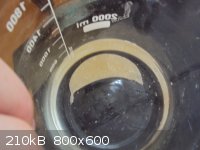 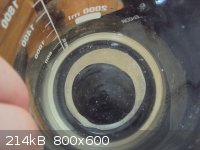 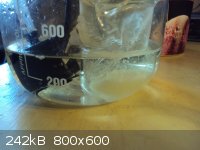 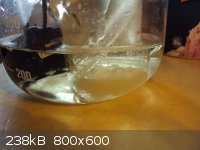 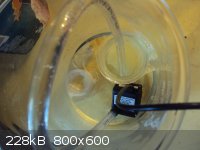
[Edited on 15-4-2012 by Hennig Brand]
|
|
|
Pulverulescent
National Hazard
   
Posts: 793
Registered: 31-1-2008
Member Is Offline
Mood: Torn between two monikers ─ "hissingnoise" and the present incarnation!
|
|
It might be simpler and safer to run cold water into NG in a tall beaker in the sink, overnight.
Adjust the rate of flow so that fairly vigorous agitation is provided, but not enough to make the NG rise from the bottom of the container.
The over-flow water will contain a certain amount of acid and a more complete wash should be achieved.
Bicarbonate solution removes less HNO<sub>3</sub> than one might expect but replacing the solution every ten minutes isn't practical . . .
"I know not with what weapons World War III will be fought, but World War IV will be fought with sticks and stones"
A Einstein
|
|
|
Hennig Brand
International Hazard
    
Posts: 1284
Registered: 7-6-2009
Member Is Offline
Mood: No Mood
|
|
I thought of that at first but then remembered NG is actually fairly soluble in water. Nitroglycerin is soluble enough that if put in a beaker with
the water constantly being replaced, in short order it would all dissolve and end up down the drain with the water, bummer.
Solubility information for NG is in this data page.
Attachment: Nitroglycerin Data Page.pdf (566kB)
This file has been downloaded 715 times
Taken from the pdf:
Water Solubility (g/L)
Temperature........Solubility
20C.......................1.38-2
40C.......................1.68
60C.......................2.36
80C.......................3.44
I am not sure how accurate these numbers are, but even if they are approximately accurate the data illustrates the issue with using a large excess of
water.
The little pump I have has a slide valve type thing on it, so the flow can be regulated. I had it turned most of the way down so that the NG was not
flushed right out of the smaller beaker into the larger beaker.
It’s the residual H2SO4 that we are more concerned with I think, but yes the HNO3 is also a concern.
With regards to the agitation from the flowing water causing the NG to rise up, I found it wasn't much of a problem at all. At the very start the
little bit of NG that was originally floating, floated off into the larger beaker. With a reasonably slow flow rate very little more than what came
over at the start ended up in the larger beaker.
[Edited on 15-4-2012 by Hennig Brand]
|
|
|
Pulverulescent
National Hazard
   
Posts: 793
Registered: 31-1-2008
Member Is Offline
Mood: Torn between two monikers ─ "hissingnoise" and the present incarnation!
|
|
| Quote: | | Nitroglycerin is soluble enough that if put in a beaker with the water constantly being replaced, in short order it would all dissolve and end up down
the drain with the water, bummer. |
Yes . . . Now that you mention it, I can see how that approach would be problematic!
"I know not with what weapons World War III will be fought, but World War IV will be fought with sticks and stones"
A Einstein
|
|
|
watson.fawkes
International Hazard
    
Posts: 2793
Registered: 16-8-2008
Member Is Offline
Mood: No Mood
|
|
Quote: Originally posted by Hennig Brand  | | This may be a little risky because of the possibility of small amounts of NG getting into the pump impeller area, but remember this process could
always be turned on and off remotely if it was deemed necessary. |
I imagine you could use a bubble pump for
this, and it has no impeller. Put the inlet in the aqueous phase the mixture and run the outlet into a funnel whose inlet is above everything. Put the
outlet of the funnel at the bottom of the mixture.
|
|
|
Hennig Brand
International Hazard
    
Posts: 1284
Registered: 7-6-2009
Member Is Offline
Mood: No Mood
|
|
That funnel idea of yours sounds like a good one, I am going to try that.
Regarding the pump, the fact that it has no impeller sounds good. I think this is the first time I have heard of one of these, sounds exotic.
Is this something practical, or a scientific curiosity of some kind?
The couple examples I came to first while googling bubble pump involved very complex systems with phase changes, vacuum pumps, specially designed
chambers and all sorts of neat stuff.
Did you have something simple in mind? I admit I am not familiar with this at all.
edit:
A Peristaltic Tube Pump might be better than the small Centrifugal Pump I am using. No impeller but it might have its own issues.
Centrifugal pumps come in many different types and made of many different materials. A centrifugal pump that had all it's internal parts covered in
teflon would be good, and they do exist.
The pump I am using is something that was pulled out of a junk pile, but it does work and is cheap. These small table-top fountain pumps are readily
available, which is something which should not be discounted either.
[Edited on 16-4-2012 by Hennig Brand]
|
|
|
watson.fawkes
International Hazard
    
Posts: 2793
Registered: 16-8-2008
Member Is Offline
Mood: No Mood
|
|
Well, coffee percolators use a bubble
pump to move water from the lower chamber to the upper one (see this link), and it's not like they're exotic or anything. In that case the pumping gas is steam, so it can use heat as the driving energy source.
Similarly, they're used in ammonia absorption refrigerators, since they're already heat-driven. They're not used widely, since their behavior depends
upon pipe dimensions, viscosity of the fluid being pumped, etc. But their ideal scale is exactly the one you're working at, so that's fine.
A bubble pump driven by an air pump need be nothing more than an inlet tube with an air injection port somewhere above the inlet. The injection port
need be little more than a pipette tip. My only particular advice is to have a variable speed air pump one way or another, perhaps with a little
pressure regulator, because it's easier to vary the air flow for optimum pumping rate than to vary the pipe diameter or the viscosity of your aqueous
phase.
|
|
|
Hennig Brand
International Hazard
    
Posts: 1284
Registered: 7-6-2009
Member Is Offline
Mood: No Mood
|
|
Ok, yeah I am starting to get the idea. This is very cool. I am seeing a lot of stuff online now on air-lift water pumps, I assume this is the same
sort of thing. I could probably just use an aquarium bubbler with check valve and a small airflow control valve and a bit of tubing.
If you have any more pointers let me know.
edit:
This afternoon I did a little experimenting. I used an aquarium air pump and vinyl tubing, which does work, but the pump is sort of underpowered and
the water is coming out in little spurts. There is probably a way to design this so there is more of a continuous stream of water. I think I read
somewhere that the air bubbles should be kept small.
I used a small air line tee fitting in the following configuration(more or less).
Return to Reservoir
|
|
|
|
|
|-------From Reservoir
|
|
|
Air in from aquarium air pump
[Edited on 16-4-2012 by Hennig Brand]
|
|
|
| Pages:
1
..
13
14
15
16
17
..
27 |